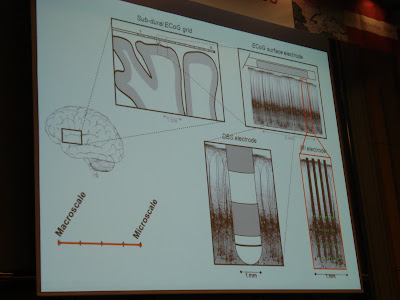I said something as soon as I could during Q&A. Clearly this was rewarding brain stimulation, strong hedonic pleasure. But didn't Schlaepfer and others report that DBS to the accumbens does not produce liking or any potential for addiction? Okun lit up, the whole issue was fascinating he said. Said they'd had no idea they'd see these behavioural responses when they began operating, but it was definitely eurphoria they were seeing. In fact, mania was occasionally a problem, one patient had stayed up all night once painting her house, ceilings and all. In those cases doctors faced the tricky choice of medicating the mania or reducing current strenght and risking the return of OCD.
I asked him again when the session was over: Had he heard my talk or seen my poster? Did he know that the euphoric deep brain stimulation response had been used as a reinforcer to motivate exercise and problem solving in rats? What did he think about applying the same method to human patients, say obese patients who need exercise? And he tells me they're working on it, they've talked about it, they've even tried electrical reward during learning trials. Said he didn't think anything had been published yet and that it wasn't his project, but gave me his card and said he'd put me in touch with the right people.
Those of you who voted '2010', you may be right.
27 Sep 2009 edit
A misunderstanding - the people in question turned out to be working on using reward signals FROM the brain to improve implant software performance, not reward signals TO the brain to improve HUMAN performance, which is what the iPlant is about.
15:59. I was so tired this morning I put both contacts in one eye.. Spent the whole morning thinking I had weird goo in my eyes blurring my vision. Arriving at the conference centre I figured 'ah! I must have forgot to put a contact in one eye'. Indeed, the left eye was naked in the mirror and I put a reserve in. Spent the day, vision still blurry, wondering if I'd caught swine flu and would go blind. Only realized my mistake as I was leaving and went to take them out and whaddayaknow, two little contacts making love on my right lens.





1 comment:
Så det kan gå när man är trött!
Förstår att du fått kontakt med väldigt intressanta människor!
Kul kul!
Den där damen som blev manisk och målade sitt hus - man skulle ju kunna säga att hon förblev OCD men bytte fokus. Huset MÅSTE målas....Stackars människa vad trött hon måste ha blivit.
puss mor
Post a Comment